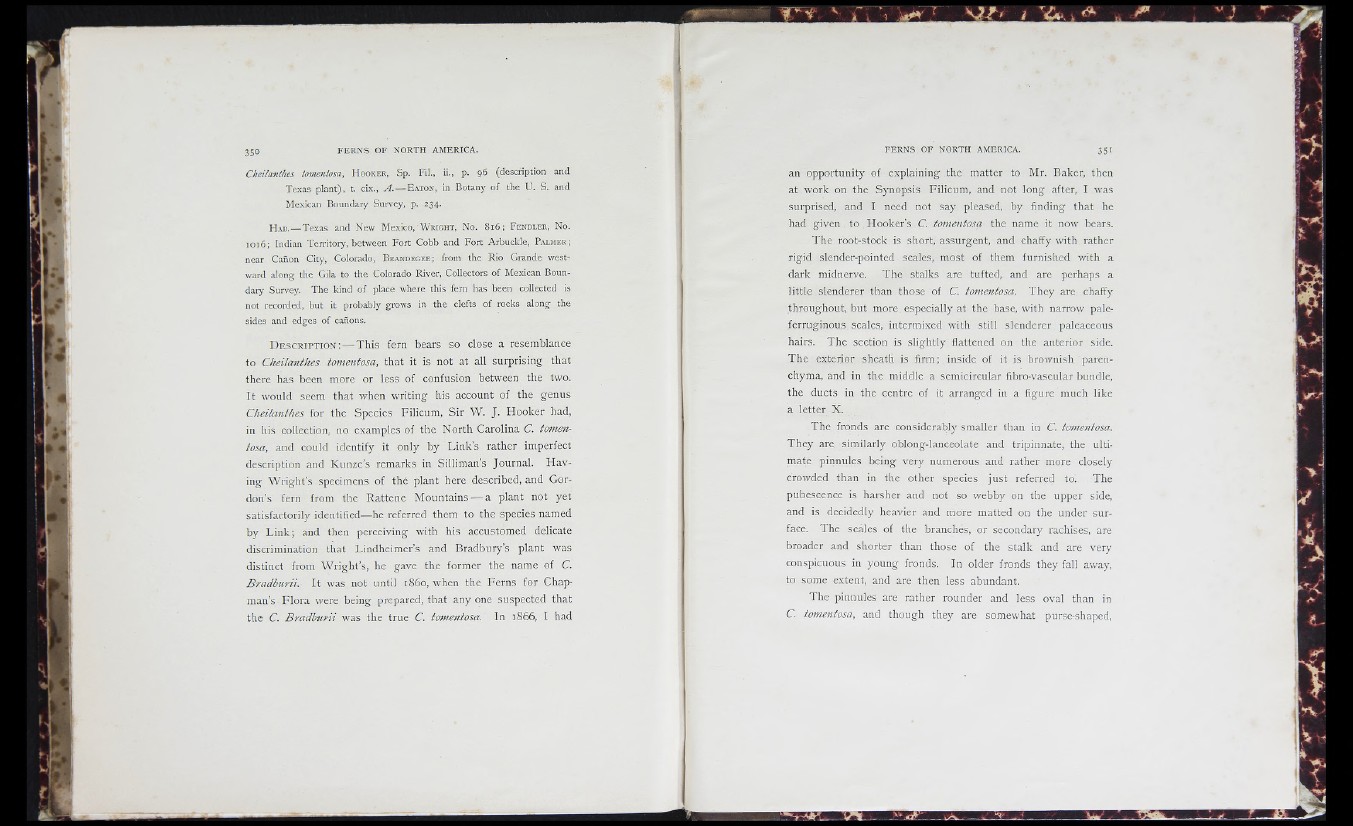
I •
h
I f
I » •
h i>
Cheilanthes tomentosa. H o o k e r , Sp. Fil., ii., p. 96 (description and
Texas plant), t. cix., A .— E a t o n , in Botany of the U. S. and
Mexican Boundaiy Survey, p. 234.
H a b .— Texas and New Mexico, W r i g h t , N o . 8 16 ; F e n d l e r , N o .
10 16 ; Indian Territory, between Fort Cobb and Fort Arbuckle, P a lm e r ;
near Cañón City, Colorado, B r a n d e g e e ; from the Rio Grande westward
along the Gila to the Colorado River, Collectors of Mexican Boundary
Survey. The kind of place where this fern has been collected is
not recorded, but it probably grows in the clefts of rocks along the
sides and edges of cañons.
D e s c r i p t i o n : — This fern bears so close a resemblance
to Cheilanthes tomentosa, that it is not at all surprising that
there has been more or less of confusion between the two.
It would seem that when writing his account of the genus
Cheilanthes for the Species Filicum, Sir W. J . Hooker had,
in his collection, no examples of the North Carolina C. tomentosa,
and could identify it only by Link’s rather imperfect
description and Kunze’s remarks in Silliman’s Journal. Having
Wright’s specimens of thè plant here described, and Gordon’s
fern from the Rattene Mountains — a plant not yet
satisfactorily identified—he referred them to the species named
by Link; and then perceiving with his accustomed delicate
discrimination that Lindheimer’s and Bradbury’s plant was
distinct from Wright’s, he gave the former the name of C.
Bradburii. It was not until i860, when the Ferns for Chapman’s
Flora were being prepared, that any one suspected that
the C. Bradburii was the true C. tomentosa. In 1866, I had
an opportunity of explaining the matter to Mr. Baker, then
at work on the Synopsis Filicum, and not long after, I was
surprised, and I need not say pleased, by finding that he
had given to Flooker’s C. tomentosa the name it now bears.
The root-stock is short, assurgent, and chaffy with rather
rigid slender-pointed scales, most of them furnished with a
dark midnerve. The stalks are tufted, and are perhaps a
little slenderer than those of C. tomentosa. They are chaffy
throughout, but more especially at the base, with narrow pale-
ferruginous scales, intermixed with still slenderer paleaceous
hairs. The section is slightly flattened on the anterior side.
The exterior sheath is firm; inside of it is brownish parenchyma,
and in the middle a semicircular fibro-vascular bundle,
the ducts in the centre of it arranged in a figure much like
a letter X.
The fronds are considerably smaller than in C. tomentosa.
They are similarly oblong-lanceolate and tripinnate, the ultimate
pinnules being very numerous and rather more closely
crowded than in the other species just referred to. The
pubescence is harsher and not so webby on the upper side,
and is decidedly heavier and more matted on the under surface.
The scales of the branchés, or secondary rachises, are
broader and shorter than those of the stalk and are very
conspicuous in young fronds. In older fronds they fall away,
to some extent, and are then less abundant.
The pinnules are rather rounder and less oval than in
C. tomentosa, and though they are somewhat purse-shaped,